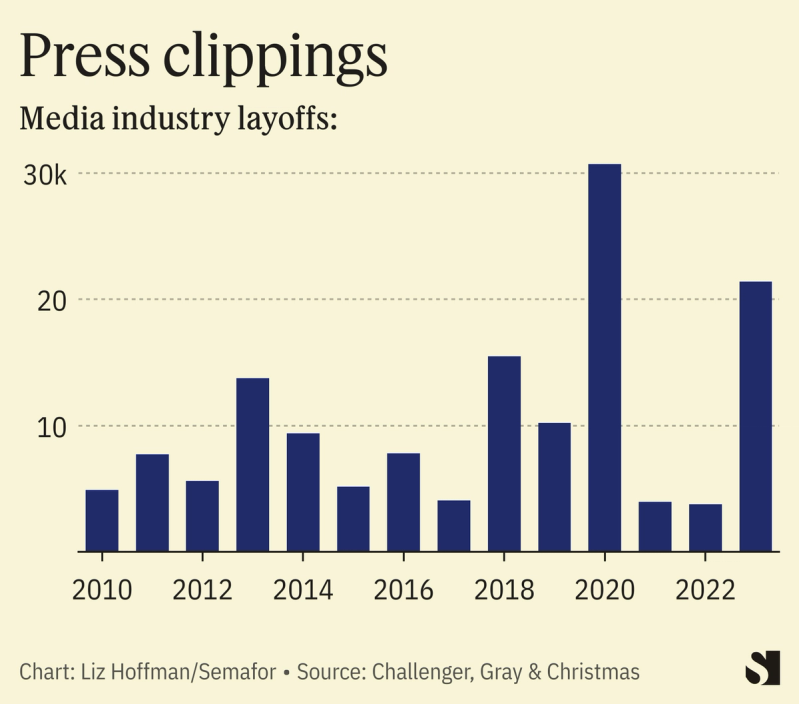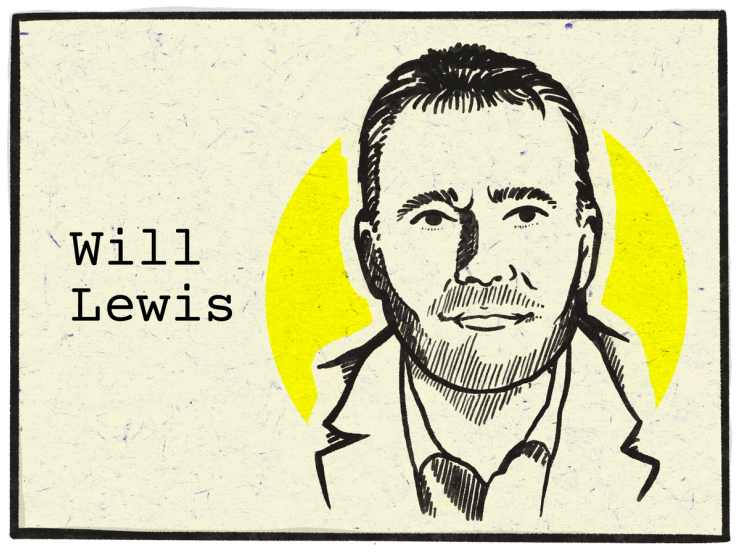On the Record
Semafor Business’ signature interview series, On The Record, brings you conversations with the people running, shaping, and changing our economy. Read Liz Hoffman’s earlier conversations with Mattel CEO Ynon Kreiz on Hollywood’s golden age of IP, Citizens Bank CEO Bruce Van Saun on the challenges for midsized banks, and Delta CEO Ed Bastian on the 2020 airlines bailout.
On Sir Will Lewis’ 17th day as CEO of the Washington Post, Washington media celebrated him in its particularly small-town way: everyone who was anyone packed into the same room at the stately home of his interim predecessor Patty Stonesifer and her husband, the journalist Michael Kinsley.
Lewis, 54, a relentlessly charming Brit whose uniform is sleek sweaters and expensive-looking sneakers, led Dow Jones from 2014 to 2020. He marks a break from the past mold of Post leaders, formally clad titans of D.C. society. And he arrived at an unsettled time for a paper Jeff Bezos rescued in 2013. The Post became a booming hub of Washington’s Trump crisis, before stalling out in the Biden years as the urgency of its core political coverage receded. Last year, the company reportedly lost about $100 million and eliminated 240 of 2,500 jobs.
But Lewis is enjoying a honeymoon with Washington and the Post’s staff alike, bringing to the newsroom an obvious love of the stuff of journalism — he was a star FT reporter in his day, quick to remind you that he broke the Exxon-Mobil scoop in 1998 — charming the paper’s unsettled reporters with deskside conversations and listening sessions.
The day after his welcome party, we met at the Post’s offices in a sparsely-furnished conference room named for the late editorial page editor Fred Hiatt. Lewis told me that he plans Tuesday to roll out his first tentative strategy, which he described as “fix it, build it, scale it,” in advance of a more formal plan he’s promised in May. Changes will range from technical — more dynamically priced subscriptions — to cultural, in the form of a renewed focus on diversity: “If we are to be the news organization for all of America, we need to look like America.” In our conversation, he offered hints about what’s to come for the Post, and the battered American news business. But Lewis is also an an inveterate dealmaker, and couldn’t quite help himself from beginning that way.
This interview was condensed and edited for clarity.
Will: If we want to do something together, we should find a way to do some business.
Ben: This is the wrong meeting.
I think us partnering with startups and people in early phases is really good for us.
I’m going to start asking you questions as though I was a reporter and you were a subject of reporting. There’s been a terrible run of layoffs in journalism every day for the last couple of weeks. What is your diagnosis?
When any journalist’s job goes, it’s more than sad, right? My hunch is that the existing model is creaking. We went from an advertising model to a subscription-based model, and that subscription-based model is now waning and then will enter a more significant period of decline.
Wait! I think a lot of publishers are just getting used to the idea of a digital subscription model. If that’s waning, what’s next?
If you want to attract people that don’t have a propensity to take that kind of monthly subscription, which is most young adult Americans, it’s going to be on the news industry to design a new way of allowing them to access our journalism. There’s very positive evidence of how news can be accessed and paid for in more innovative ways. There are day passes that are successful, there’s week passes, there are models like the Guardian where you can make donations. So there’s a whole new generation of paying user concepts. I’m pretty excited about it. I think it’s newsroom 3.0.
We can definitely improve and get more subscribers with the existing set-up. We definitely want to bring new products and services. But the really exciting bit is to then bring scale, and that’s where you’ll see us embracing a much greater degree of personalization. You’ll see us embracing AI in a much more effective way.
You’ve said you don’t think there’ll be a “Trump Bump.” How can you grow without it?
I do think we’re going to go through a growth phase in this next period. We can do a lot better at showcasing exactly what we do now. There’s the core proposition, which is politics, policy investigations and opinion. It’s those obsessions. And we will definitely grow our readership in those areas. But we have to do it while also letting people into our Aladdin’s Cave of our other journalism. And that’s a product issue, that’s a marketing issue.
That sounds a little like someone who is going to have to cut costs and isn’t going to be able to spend new money. Do you think you’ll have to cut costs?
No, I’m here to grow the business. We are blessed, and I don’t take it for granted, with a very supportive owner who has already spent a lot of money in the last 10 years on this organization, but is, in his own words, just getting started.
News is what we do. We exist to deliver news. We just need to do better at how we get that news to people. So for example, if 150 million Americans are using TikTok every day on a regular basis, we can learn a lot by how they are accessing their content.
We’re a news organization. We’re the most important news organization in America.

The conventional wisdom is that the New York Times is the most important news organization in America. Do you think the Times (which has built a broad bundle from cooking to games) is no longer a news organization?
I’ve got two golden rules in my life in this phase. One is every time I have a chance, I’m going to mention Evan [Gershkovich, a journalist imprisoned in Russia] and Austin Tice [a journalist kidnapped in Syria in 2012].
And second, I’m never going to mention my competitors.
Firstly, we are in a very strong position, right? We have 2.5 million subscribers and they are really loyal subscribers. The engagement is off the scale. Some of our pieces get 7,000, 8,000 comments.
And secondly, you can’t overstate — there is such support for the Washington Post from everyone from other media, from business, from politicians, from both sides.
This is a very, I think, unique situation.
Do you think the Post has escaped becoming the kind of partisan brand that others have?
For those that read our brilliant opinion section, if you read our news, if you read our Hunter Biden art sales story yesterday; if you read our balanced and incredibly interesting coverage about Trump-Haley; if you do that, then you will know that we are the most objective news organization in America and we have the most balanced, diverse opinion section where we have opinions from all sorts of people. It’s like an oasis of calm and considered thought.
In 2006, the top political reporter and the political editor of the Post quit to start Politico. In 2016, one of them left to start Axios. Jake Sherman and Anna Palmer, who were part of that crew, left Politico to start Punchbowl in 2021. And they built three very successful media businesses in your backyard in Washington. Are we going to see the Washington Post going to enter a newspaper war with them?
I mean, wow, what they’ve achieved! And I’m kind of proud that this organization has spawned such incredible entrepreneurs who have gone to produce really high quality stuff, and I’m a big user of theirs. I couldn’t talk highly enough of all of that lot.
Would you consider acquiring Punchbowl?
I think you’ll find that acquisitions will be part of how we’re going to grow. But my hunch is that the industry is changing so rapidly that actually probably social, AI, and personalization are the next opportunities. So the newsletter stuff — we have great newsletters, and they’re going to get better. But the next phase is probably not trying to copy what was done five years ago, but to move forward.
So you’re looking to go to make the Post’s footprint bigger, not to drill into smaller Washington lanes?
One of the many things we’re blessed with is that we’re probably one of the few mastheads in America that can help other news organizations and can think about aggregation. The fundamental challenge for the news industry is how, how do you deliver ever more specific verticals — people really, really want to know about the widget industry, but there’s only 1000 of them. How do I charge them enough? This is the fundamental challenge we’re facing and no one’s cracked it yet. We can play at an aggregation level.
A critical part of content strategy in a sophisticated subscription offering is local. So we’re going to have to find ever more innovative ways of not just in D.C., but elsewhere across America, of enabling that to be part of what we do and we’re very early, but we’ll be working with colleagues on how we do that. We’ve had a little innovation project underway out of Kansas, which gave us a bit of a taste of how we could do something significant at scale in local.
How are you finding Washington? It’s a very earnest place.
I knew I wanted to be a journalist from a very young age. And whether it was Watergate or the Pentagon papers — the Post is such a significant thing in our lives. I’m a British boy, born in London, but it’s hard to overstate how important it was. I’ve had a long love affair with this place. So it’s not a Washington thing for me. It’s a Washington Post thing.
What’s your favorite story the Post has published so far in your tenure?
I’ve been reading the Post for years, but I had obviously stepped up my consumption as I thought I’m going to come and work here. And so I did the Newsprint thing. It’s a really brilliant app and it gives you the video of your favorite journalist. It’s the guy who was there last night in the red tie, glasses — Michael Scherer. He came to my dinner and I said, ‘Hey, you’re my favorite.’ So I love this stuff, right?
correction
The chart has been updated to reflect that the data refers to industry-wide media layoffs, not only in newsrooms.


